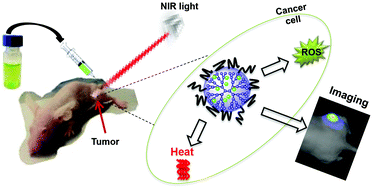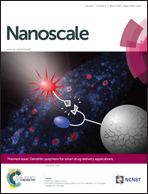Dendrimer-encapsulated naphthalocyanine as a single agent-based theranostic nanoplatform for near-infrared fluorescence imaging and combinatorial anticancer phototherapy†
Abstract
Multifunctional theranostic platforms capable of concurrent near-infrared (NIR) fluorescence imaging and phototherapies are strongly desired for cancer diagnosis and treatment. However, the integration of separate imaging and therapeutic components into nanocarriers results in complex theranostic systems with limited translational potential. A single agent-based theranostic nanoplatform, therefore, was developed for concurrent NIR fluorescence imaging and combinatorial phototherapy with dual photodynamic (PDT) and photothermal (PTT) therapeutic mechanisms. The transformation of a substituted silicon naphthalocyanine (SiNc) into a biocompatible nanoplatform (SiNc-NP) was achieved by SiNc encapsulation into the hydrophobic interior of a generation 5 polypropylenimine dendrimer following surface modification with polyethylene glycol. Encapsulation provides aqueous solubility to SiNc and preserves its NIR fluorescence, PDT and PTT properties. Moreover, an impressive photostability in the dendrimer-encapsulated SiNc has been detected. Under NIR irradiation (785 nm, 1.3 W cm−2), SiNc-NP manifested robust heat generation capability (ΔT = 40 °C) and efficiently produced reactive oxygen species essential for PTT and PDT, respectively, without releasing SiNc from the nanopaltform. By varying the laser power density from 0.3 W cm−2 to 1.3 W cm−2 the therapeutic mechanism of SiNc-NP could be switched from PDT to combinatorial PDT–PTT treatment. In vitro and in vivo studies confirmed that phototherapy mediated by SiNc can efficiently destroy chemotherapy resistant ovarian cancer cells. Remarkably, solid tumors treated with a single dose of SiNc-NP combined with NIR irradiation were completely eradicated without cancer recurrence. Finally, the efficiency of SiNc-NP as an NIR imaging agent was confirmed by recording the strong fluorescence signal in the tumor, which was not photobleached during the phototherapeutic procedure.

- This article is part of the themed collection: Dendritic Polymers for Smart Drug Delivery Applications

 Please wait while we load your content...
Please wait while we load your content...